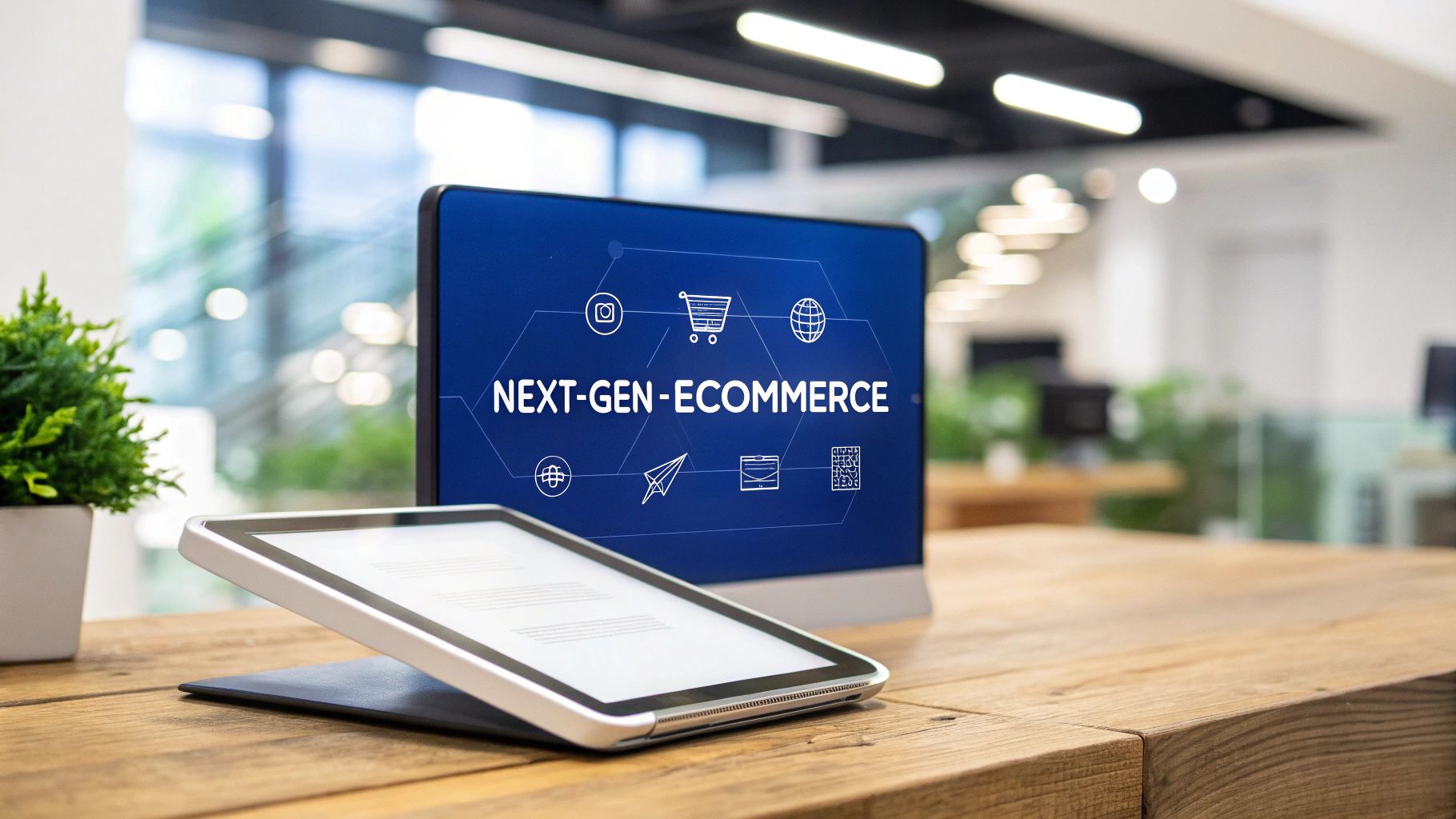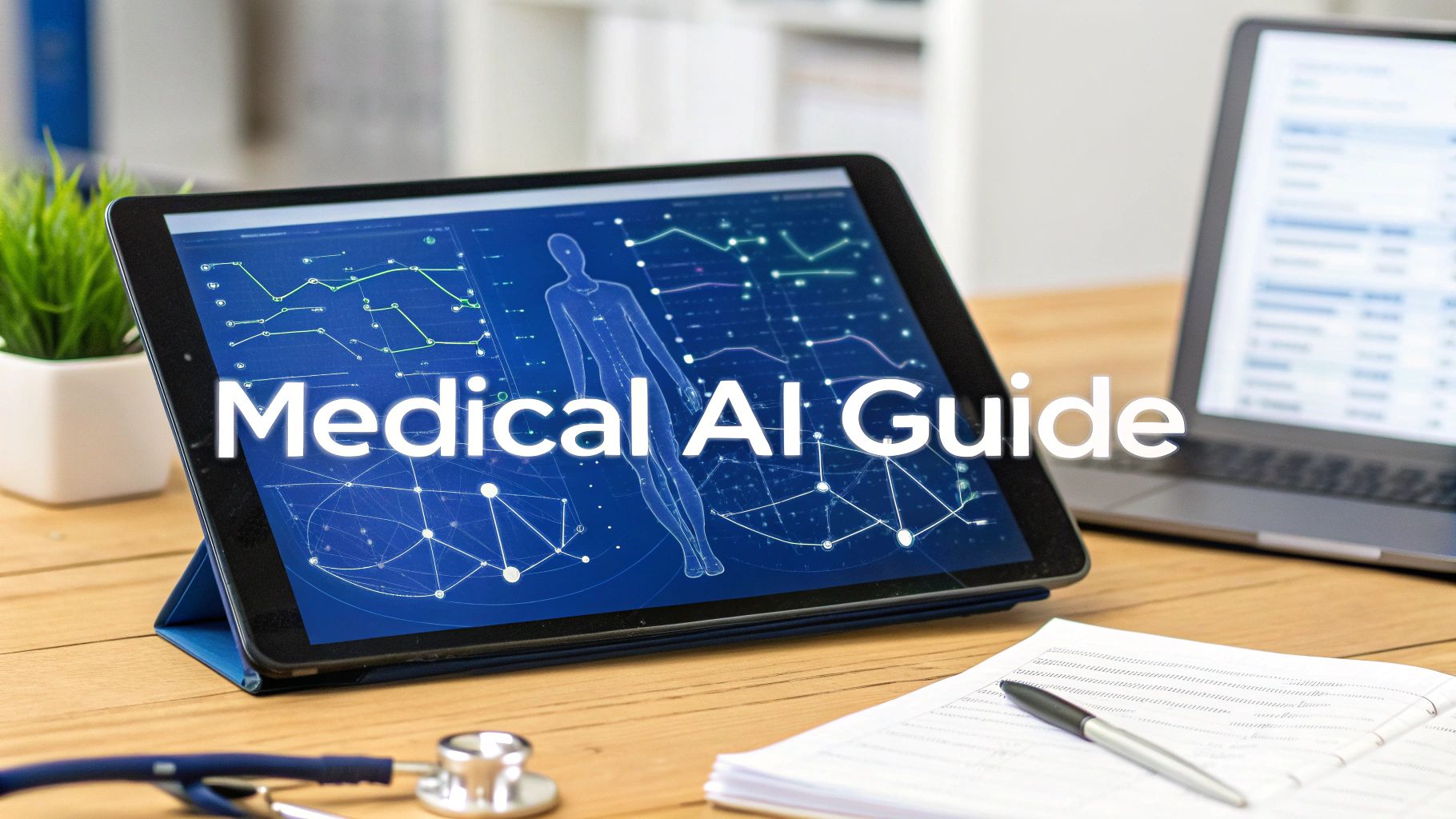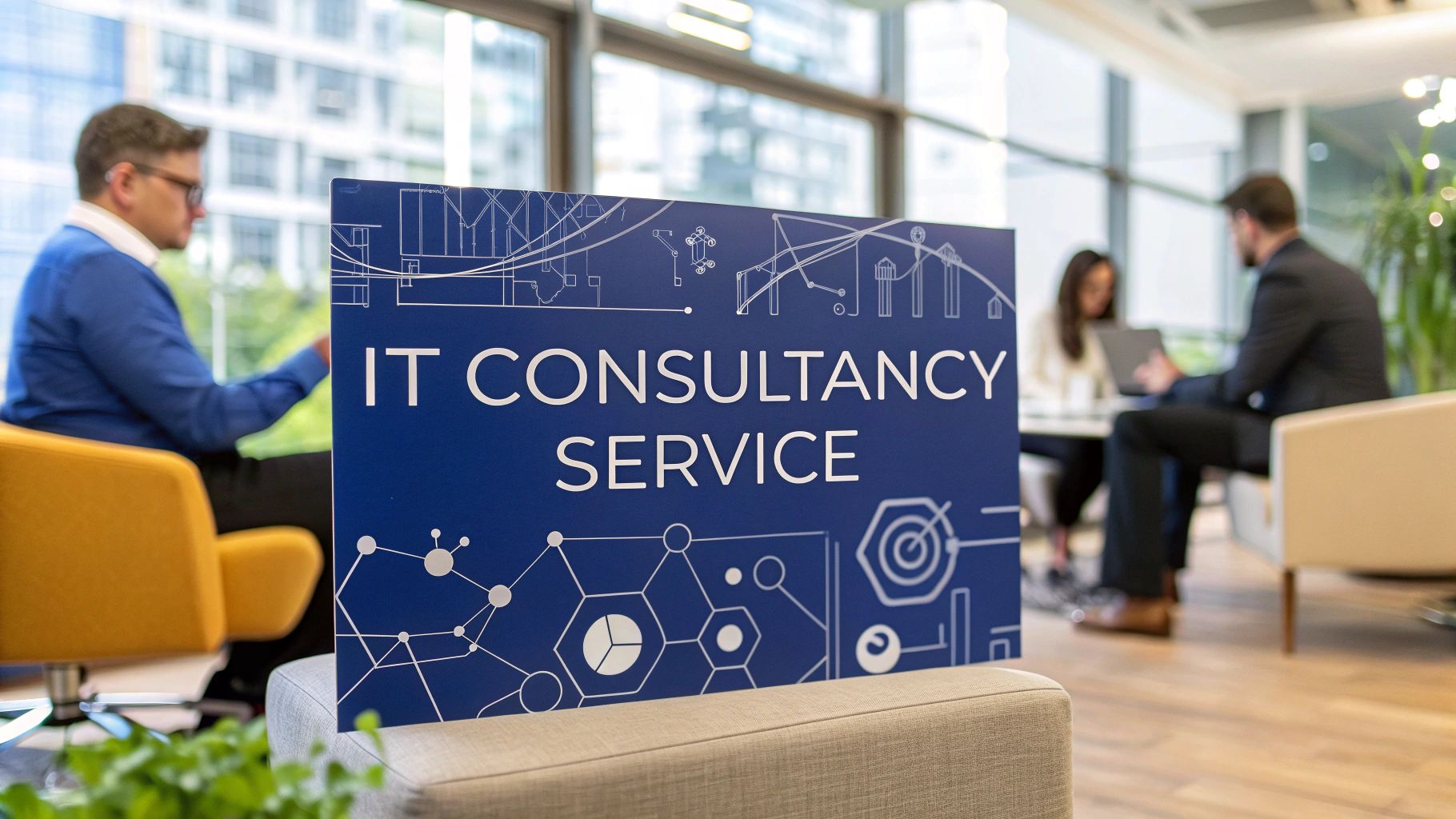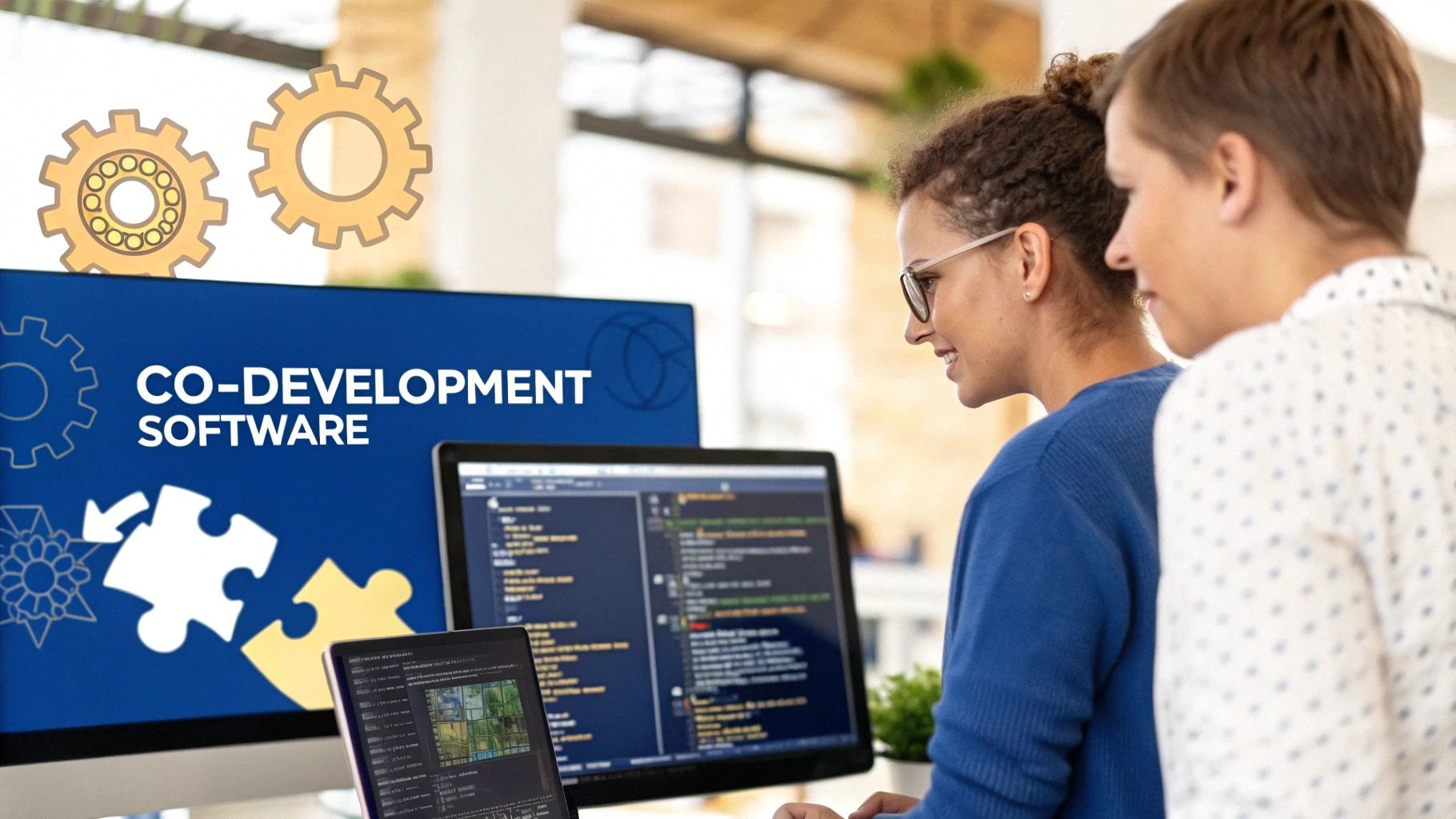The days of the simple online shopping cart are long gone. Today, next-gen ecommerce software isn’t just an upgrade; it's a completely different way of thinking. We've moved from static digital storefronts to intelligent, interconnected ecosystems built to deliver highly personalised and fluid customer experiences, no matter where the customer is. This is the new baseline for digital retail.
Understanding the Ecommerce Revolution

The evolution in ecommerce isn't just about selling products online anymore. It’s about crafting adaptive, data-driven journeys that feel like they know what a customer wants before they do. This massive change is being pushed forward by two powerful forces: sky-high customer expectations for smooth interactions and huge leaps in technology. Shoppers today demand a consistent experience, whether they’re using a mobile app, browsing a website, or interacting with a kiosk in a physical store.
This new chapter in digital commerce is built on a few core pillars that set it apart from older platforms. We are finally breaking free from clunky, one-size-fits-all solutions and embracing architectures that are far more flexible and powerful.
Three key drivers are at the heart of this shift:
-
AI-Powered Personalisation: We’re moving beyond basic "you might also like" recommendations to create truly individualised shopping moments. We explore this in more detail right here: https://www.cleffex.com/blog/ai-in-ecommerce-transforming-retail-success/.
-
Headless and Composable Architectures: By separating the customer-facing "head" (the website or app) from the back-end commerce engine, brands gain incredible freedom to create unique experiences and innovate faster.
-
Omnichannel Consistency: This ensures a seamless brand and shopping journey across every touchpoint, from a social media ad to the checkout counter in a brick-and-mortar store.
The Accelerating Market Growth
The surging demand for these sophisticated solutions is easy to see in the market’s explosive growth. The eCommerce software market in the United States, valued at an estimated USD 7.12 billion in 2022, has been expanding rapidly as more businesses go digital. Projections show this growth continuing at a fast pace, highlighting just how critical it is for businesses to keep up.
This isn't just a trend; it's a clear signal of where the market is headed. Companies that stick with old, rigid systems risk being outmanoeuvred by competitors who are already using these powerful new tools to their advantage.
The real story isn't just about better technology. It's about completely rethinking the relationship between a brand and its customers. It's about building a digital ecosystem that's as responsive and intuitive as the best in-person sales assistant you've ever met.
Embracing a New Digital Reality
This shift isn’t happening in a vacuum; it’s the result of many different technologies coming together. For a closer look at how deep these changes go, understanding how crypto is redefining ecommerce transactions offers a glimpse into another piece of the digital commerce puzzle. Making the move to next-gen ecommerce software is the first essential step in building a resilient, future-ready retail operation that can thrive in this constantly changing environment.
The Core Technologies Behind Modern Ecommerce
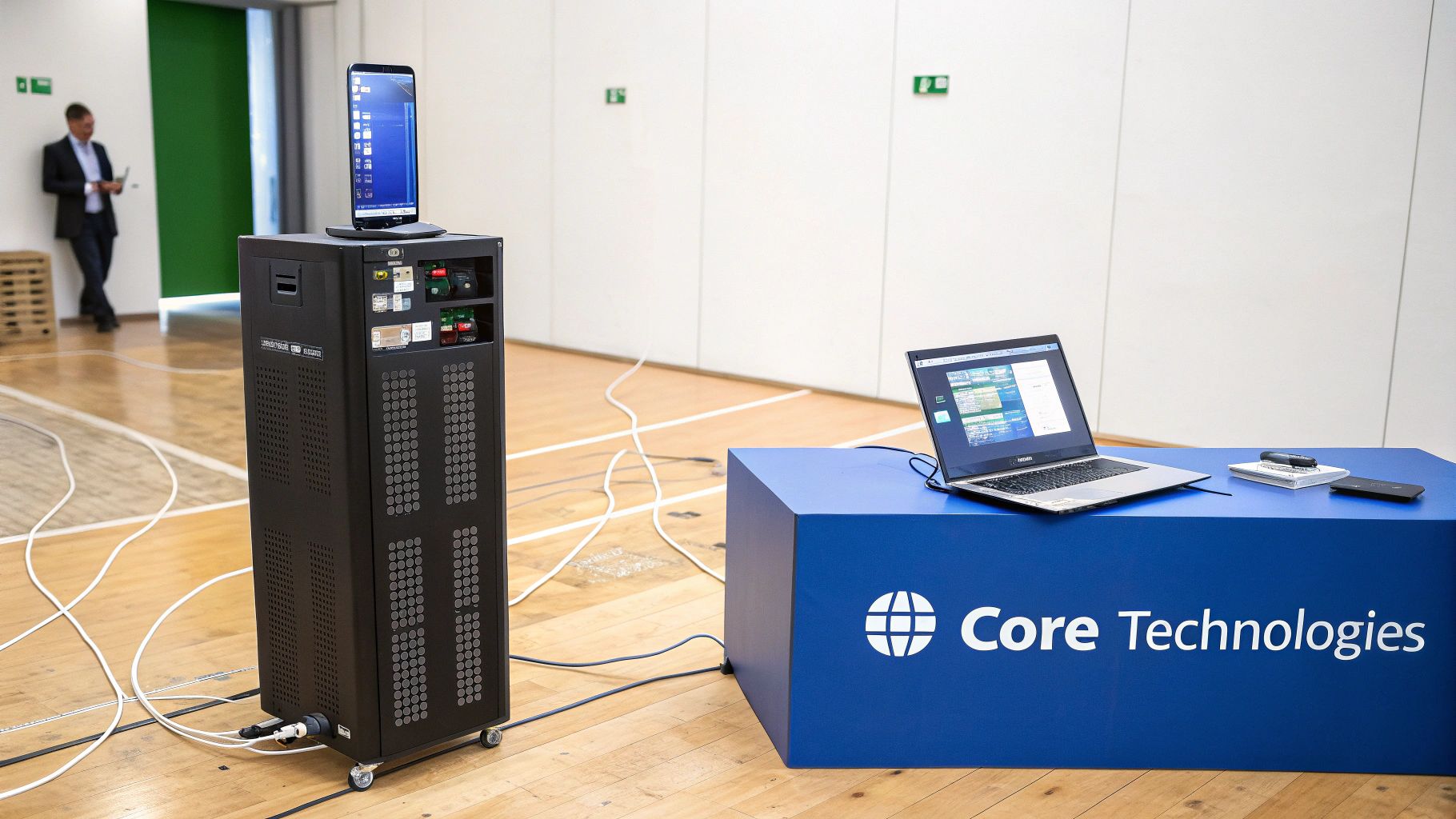
To really get what sets modern retail platforms apart, we need to pop the hood and look at the technologies powering them. This isn't about getting lost in technical jargon. It's about a fundamental shift away from clunky, one-size-fits-all systems toward a more flexible, intelligent, and interconnected way of doing business online. These are the engines that deliver the seamless, personalised experiences customers now demand.
The big idea is to ditch the monolithic platform that tries (and often fails) to do everything. Instead, the focus is on assembling a team of specialised, best-in-class tools that work together in perfect harmony. This gives you the freedom to build a digital commerce ecosystem that fits your business like a glove, rather than forcing you into a box.
Headless Commerce: The Universal Content Engine
Think of your ecommerce back end – the part that handles products, inventory, and orders – as the brain of your operation. In old-school systems, that brain is permanently fused to one body: your website's front end. Headless commerce cuts that cord, letting the brain power countless different bodies at once.
This "decoupled" approach means your single back-end system can push content and process sales on any front end you can dream up:
-
A standard website and a mobile app.
-
An in-store kiosk or a smart mirror in a fitting room.
-
Voice assistants and wearable tech.
-
Social media shops and online marketplaces.
The result is total consistency. Change a price in your back end, and it updates instantly everywhere. This flexibility is crucial for modern ecommerce software development, letting businesses innovate on the customer-facing side without having to tear down their core infrastructure. To dig deeper, check out our guide on the most popular headless architecture technologies.
AI And Machine Learning: Your Personal Shopping Assistant
Artificial intelligence (AI) and machine learning (ML) act like personal shoppers for every single visitor. These technologies sift through mountains of data – browsing habits, purchase history, even real-time clicks – to create experiences that feel genuinely one-on-one. AI doesn't just make generic suggestions; it anticipates what your customer wants next.
AI transforms data from a simple record of what happened into a predictive tool for what will happen next. It's the difference between looking in the rearview mirror and having a GPS that guides your future path.
For example, an AI-powered search bar can understand a natural query like, "I need an outfit for a summer wedding," and show relevant results. It can also manage dynamic pricing, adjusting offers based on demand, or automate inventory by predicting sales trends with scary-good accuracy.
Composable Commerce: Building With Best-In-Class Tools
If headless commerce separates the front end from the back end, composable commerce explodes that idea into its individual components. It lets you build your entire commerce setup with best-of-breed tools, like putting together a custom stereo system instead of buying an all-in-one boombox.
Instead of being stuck with one vendor for every function, you can pick and choose the absolute best solution for each specific need and "compose" them into a single, powerful system.
This modular approach makes you incredibly agile. Want the market's best search tool? Plug it in. Need a highly specialised subscription management platform? Add it to the mix. This model is central to next-gen ecommerce software and means you're never held back by a single platform's weak spots. A key part of this is using advanced ecommerce automation tools to streamline your operations, and a composable setup makes adding them a breeze. It’s all about creating a truly bespoke platform, supported by expert software development services, that’s built for your exact needs.
To really see the difference, it helps to compare the old way with the new.
Comparing Traditional vs Next-Gen Ecommerce Architectures
| Feature | Traditional Ecommerce | Next-Gen Ecommerce |
|---|---|---|
| Architecture | Monolithic (all-in-one) | Decoupled & Composable (modular) |
| Flexibility | Rigid, limited by the platform | Highly adaptable, "best-of-breed" tools |
| Customer Experience | Standardised, one-size-fits-all | Personalised & omnichannel |
| Scalability | Often difficult and expensive | Natively scalable and elastic |
| Speed to Market | Slow, lengthy development cycles | Fast, rapid deployment of new features |
| Vendor Lock-In | High, difficult to switch | Low, individual components can be swapped |
This table makes it clear: the shift to next-gen isn’t just an upgrade; it's a complete rethinking of how digital commerce should work. You move from a restrictive environment to one of limitless possibilities.
Turning Customer Data Into Your Greatest Asset
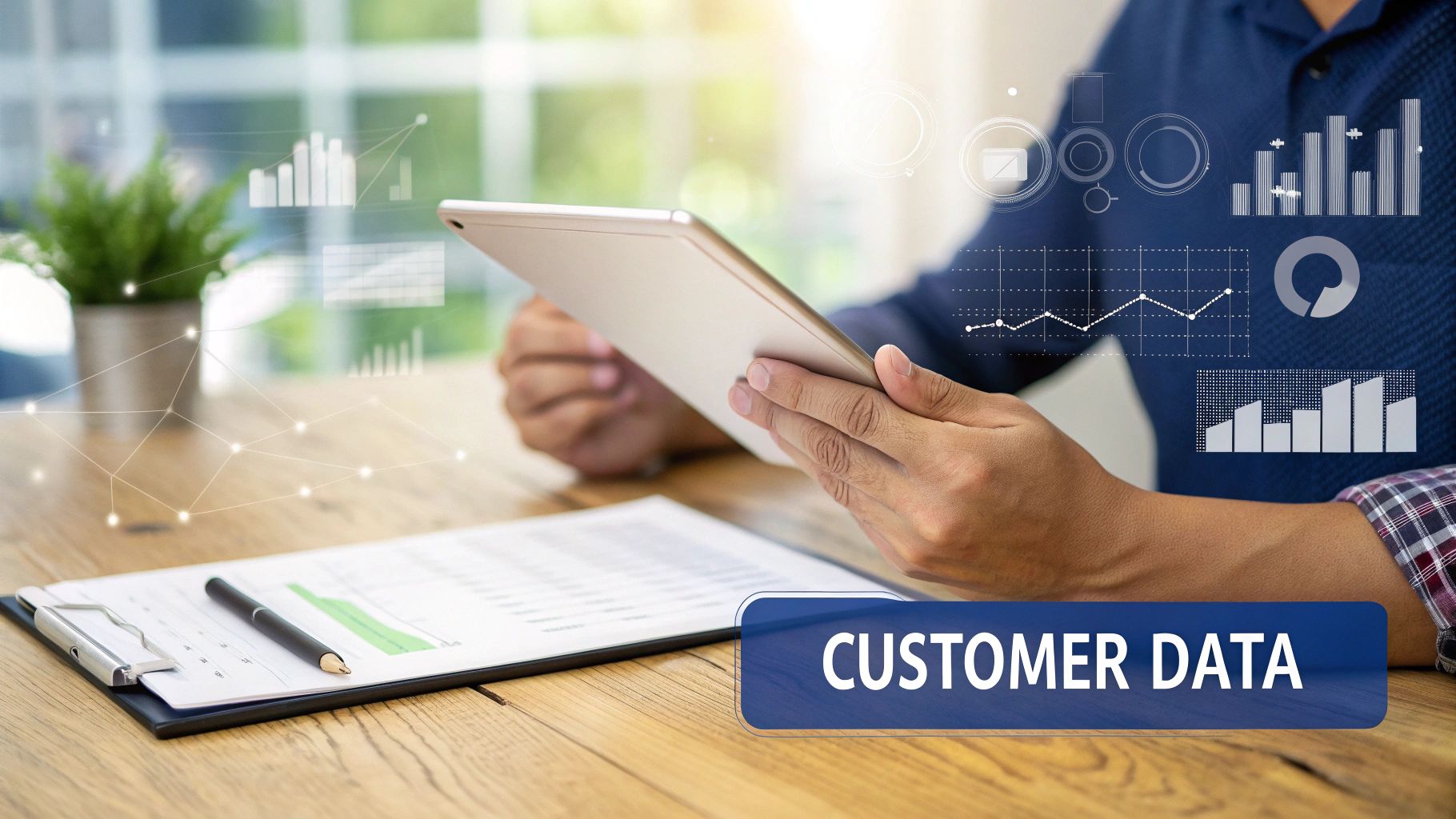
In today's retail world, data is the lifeblood of your entire ecommerce operation. Simply looking at basic sales reports won't cut it anymore if you want to stay competitive. The real magic happens when next-gen ecommerce software takes raw information and turns it into a genuine strategic advantage.
We're talking about using predictive analytics and sophisticated customer segmentation to drive real, measurable growth. It's not just about tracking what someone bought last week; it's about confidently predicting what they'll be looking for next month. By analysing everything from browsing patterns to purchase histories, you can shift from just reacting to sales to proactively engaging with your customers.
From Numbers To Narratives
Think about it: every click, every search, and every purchase tells a little story about your customer. Modern platforms are built to listen to these stories and translate them into business intelligence you can actually use. This helps you understand not just what people are buying, but the why behind their decisions.
Once you have that deeper understanding, you can unlock some seriously powerful strategies:
-
Hyper-Personalised Marketing: Forget one-size-fits-all email blasts. You can create campaigns that speak directly to an individual’s interests and past behaviour. You can learn more about ecommerce personalisation in our detailed guide on the topic.
-
Dynamic Pricing Adjustments: Imagine automatically tweaking prices based on real-time demand, a competitor's stock levels, or even a specific shopper's browsing history. That's how you maximise conversions.
-
Accurate Inventory Forecasting: Use predictive models to see what’s coming. This means less risk of overstocking items that won’t sell and never running out of your bestsellers again.
This smart use of data is quickly becoming non-negotiable for successful online retailers. In fact, the market for customer analytics in ecommerce is expected to jump from USD 14.9 billion in 2025 to roughly USD 49.2 billion by 2035. California ecommerce businesses are already at the forefront, using AI-driven analytics to get ahead.
Building Trust Through Data Responsibility
Of course, with great data comes great responsibility. Having the power to collect and analyse customer information has to be balanced with a deep respect for their privacy. Regulations like the California Consumer Privacy Act (CCPA) aren't just legal hoops to jump through; they're a chance to prove you're a brand customers can trust.
Viewing data privacy compliance as a trust-building exercise rather than a burden is a hallmark of a mature, customer-centric brand. When customers feel their data is safe, they are more willing to engage deeply with your business.
Transparent privacy policies and clear consent options are crucial. They show customers you value them and their trust above all else. This approach doesn't just keep you compliant; it fosters a kind of loyalty that a simple transaction never could.
The Data-Centric Advantage
Ultimately, the goal is to create a positive feedback loop. Better data leads to better customer experiences. Better experiences encourage customers to share more data, which allows for even more meaningful personalisation. It's a powerful cycle. By making customer data your most valuable asset, you're not just improving sales, you're building a resilient, adaptable business that’s ready for whatever comes next.
Real-World Business Benefits and Use Cases
The true value of modern ecommerce technology isn't in the buzzwords or abstract features. It becomes crystal clear when you see how it solves real, specific problems for businesses at different stages of their journey. We're talking about tangible outcomes that boost revenue, make your team more efficient, and help build customer relationships that last.
For businesses of all shapes and sizes, these advanced platforms are a genuine game-changer. They open up access to powerful tools that, not too long ago, were only available to massive corporations with equally massive IT budgets.
Levelling The Playing Field For Small Businesses
If you're running a small or mid-sized business (SMB), the biggest win here is simple: democratisation. Next-gen ecommerce software gives you the kind of automation and personalisation tools that level the playing field, empowering smaller brands to go toe-to-toe with established giants.
Think about all the manual, time-sucking tasks that eat up your day. Now, imagine automating them.
-
Marketing Automation: You can set up personalised email campaigns that trigger automatically based on what a customer does, like abandoning a cart or making a purchase. It's like having a marketing assistant working 24/7.
-
Inventory Management: Instead of guessing, you can use predictive analytics to get a much better handle on demand. This helps prevent frustrating stockouts and protects your bottom line.
-
Customer Service: AI-powered chatbots can handle the common, repetitive questions around the clock, which frees up your team to focus on the more complex issues where a human touch really matters.
This kind of efficiency means a small, nimble team can achieve what used to require a much larger staff. It lets you and your people focus on the creative work and big-picture strategy, not just the daily grind.
For an SMB, adopting these tools is like equipping a small, agile speedboat with the navigation system of a super-yacht. It allows you to navigate the competitive waters with precision and speed, reaching your destination much faster.
This strategic edge is absolutely critical in crowded markets. Take California, for example; it's a massive hub for online retail, with businesses there accounting for a staggering 35% of all ecommerce orders across the top four US states. To stand out in that kind of environment, you need the sophisticated, user-friendly solutions that modern platforms offer. If you're curious about these regional dynamics, you can read the full research about eCommerce platform stats in California.
Fuelling Scalability For Mid-Market Companies
As a business starts to really grow, it often hits a wall. The platform that got you off the ground suddenly feels restrictive. Mid-market companies face a tricky set of challenges: scaling operations smoothly, expanding into new countries, and managing logistics that get more complex by the day.
This is where the flexibility of next-gen platforms really starts to shine. They're built from the ground up to support rapid growth without forcing you into a complete, and very expensive, replatforming project every few years.
Here’s what that means for a growing business:
-
Seamless Internationalisation: Headless architectures make it surprisingly simple to spin up new storefronts for different countries, languages, and currencies, all while managing everything from a single back-end.
-
Complex Supply Chain Management: You can easily integrate with multiple warehouses, third-party logistics (3PL) providers, and dropshipping partners. This creates a fulfilment network that's not just efficient, but also resilient.
-
API-First Integration: These platforms are designed to talk to other systems. Connecting to your essential business tools like an Enterprise Resource Planning (ERP) or Customer Relationship Management (CRM) system is straightforward, ensuring data flows smoothly across the entire company.
The ability to scale without all that friction is a huge advantage. It means you can chase aggressive growth goals with the confidence that your technology backbone won't just keep up – it will help lead the way.
Achieving Omnichannel Excellence For Enterprises
For large enterprises, the name of the game is omnichannel consistency. Today's customers expect a flawless, unified brand experience whether they're browsing your website, using the mobile app, or walking into a physical store. Old, legacy systems make this dream nearly impossible to execute.
Enterprise-grade next-gen ecommerce software cracks this code by creating a single source of truth for all your product, customer, and order data. This is what enables those powerful, unified experiences we all love, like buying online and returning in-store, or starting a shopping cart on a laptop and finishing it on a mobile app without a single hiccup.
By integrating deeply with the complex web of existing corporate systems, these platforms help foster a culture of rapid innovation. As we explored in our end-to-end ecommerce software solutions guide, this connected approach is fundamental to success in modern retail. The takeaway is clear: the right technology offers specific, tailored advantages for every stage of business growth, making it a cornerstone of any forward-thinking strategy.
Your Practical Roadmap For Implementation
Jumping to a new ecommerce platform can feel like a massive undertaking, but when you break it down into a clear, manageable roadmap, it becomes far less intimidating. This isn't about flipping a switch overnight. It's a strategic journey that, when planned properly, guarantees a smooth transition and sets you up for years of success.
The trick is to approach implementation with a solid plan that anticipates the bumps in the road. With the right strategy, you can confidently move your operations, get your team up to speed, and start seeing the real-world benefits of a modern, flexible system.
This visual shows the typical growth journey that makes a platform upgrade necessary, moving from the needs of a small startup to the complex demands of a large enterprise.
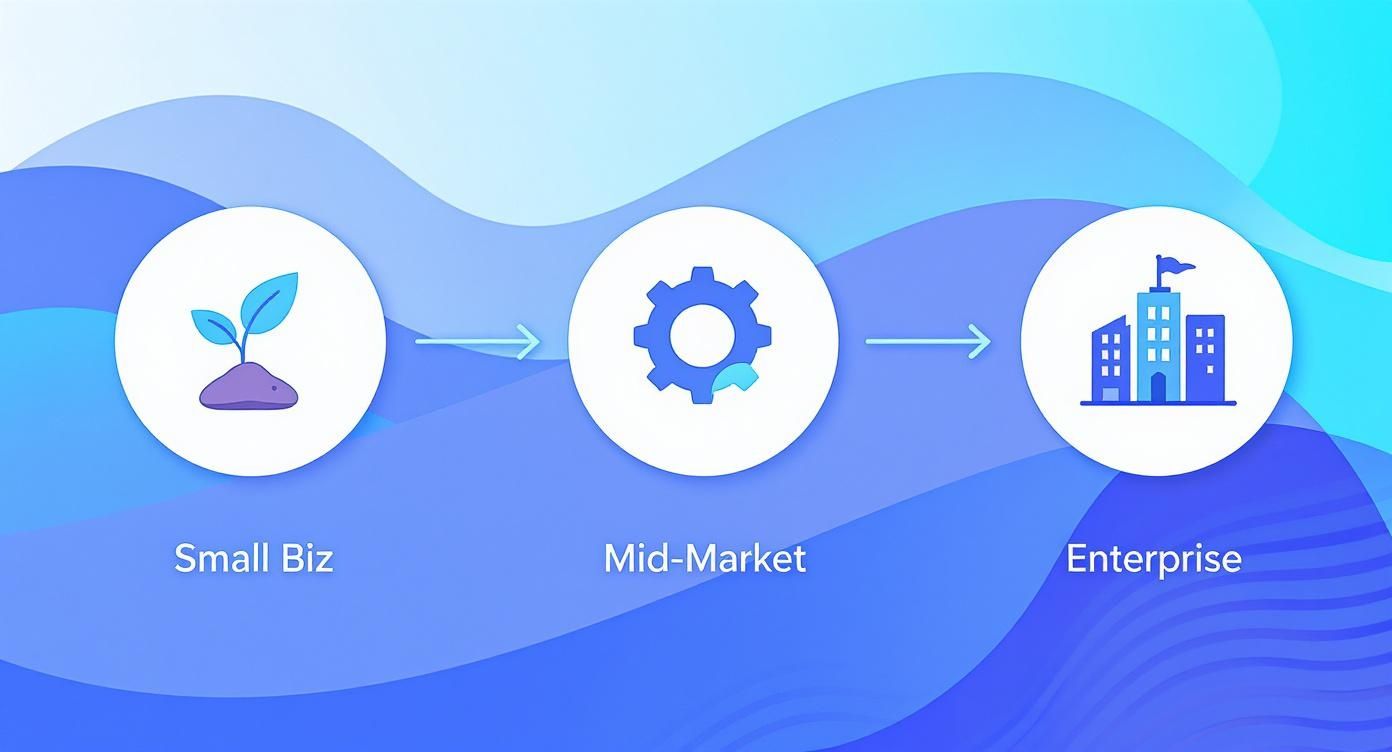
As you can see, the technology you need changes dramatically as your business scales, which is why a phased, thoughtful implementation is so critical.
Phase 1: Discovery And Audit
Before you even glance at new software, the most critical first step is to look inward. The discovery and audit phase is all about getting a brutally honest assessment of where you are now and a crystal-clear vision of where you want to go. This groundwork prevents expensive missteps later.
Kick things off with a thorough audit of your current systems. What drives your team crazy? Where are the bottlenecks in your daily workflow? What specific limitations are stunting your growth?
Next, set clear, measurable business goals for the new platform. These objectives become your North Star for the entire project.
-
Define Key Performance Indicators (KPIs): Don’t just aim for "better sales." Get specific. Think: "increase conversion rate by 15%" or "reduce cart abandonment by 20%."
-
Map Out Technical Requirements: Make a detailed list of every single integration you can't live without, from your accounting software to your email marketing tools.
-
Involve Key Stakeholders: Talk to everyone. Get input from marketing, sales, customer service, and the warehouse team. Their on-the-ground insights are pure gold.
Phase 2: Vendor And Architecture Selection
Once you know exactly what you need, you can start weighing your options. This phase is about choosing both the right technology architecture and the right people to help you build it. You’ll generally be looking at three main models.
-
SaaS (Software-as-a-Service): These are the ready-made platforms that offer a fast and often more affordable way to get started. They're fantastic for businesses that need to get to market quickly, but can feel restrictive if you need deep customisation.
-
Custom Development: Building a platform from scratch gives you total control and unlimited flexibility. This is the path for businesses with truly unique requirements that no off-the-shelf solution can handle. It's a core focus of our ecommerce software development expertise.
-
Hybrid (Composable) Model: This popular approach gives you the best of both worlds. You start with a core commerce engine and then plug in best-in-class third-party tools for things like search, payments, and personalisation.
Choosing the right architecture isn't about finding the "best" one; it's about finding the best one for your business. Your decision should tie directly back to the goals you hammered out in the discovery phase.
Working with an experienced team is non-negotiable here. The right partner won't just build the tech; they'll help guide your strategy. Our software development services are built to provide exactly that kind of strategic partnership.
Phase 3: Phased Rollout And Data Migration
Now for the main event – moving from your old system to the new one. A "big bang" launch, where everything changes at once, is incredibly risky. A much safer and smarter strategy is a phased rollout.
This could mean launching the new site for just one product category to start, or maybe rolling it out to a small segment of your customer base. This approach lets you test, gather real feedback, and squash bugs in a controlled environment before the full-scale launch.
Data migration is often the trickiest part of this whole phase. Moving customer accounts, order histories, and product catalogues demands careful planning and double-checking every detail.
Actionable Tips for a Smooth Migration:
-
Clean Your Data First: Before you move a single byte, clean up your existing data. Get rid of duplicates, fix errors, and standardise formats. It's tedious but essential.
-
Run Multiple Tests: Perform several trial migrations in a staging environment. This is how you'll catch and fix problems before they affect real customers.
-
Communicate and Train: Keep your team in the loop constantly. Provide thorough training on the new system long before launch day so everyone feels confident and prepared.
This structured roadmap turns a daunting project into a series of achievable steps. By focusing on smart planning, strategic selection, and a methodical rollout, you can successfully implement your next-gen ecommerce software and open the door to brand new opportunities for growth.
Building Your Future-Proof Retail Engine
Moving to next-gen ecommerce software isn't just a tech upgrade; it's a core business decision that sets you up for years of growth and stability. The benefits are impossible to ignore: a far better experience for your customers, smoother day-to-day operations, and the power to make decisions based on real data, not guesswork. Think of these as the essential pillars for building a retail operation that can withstand whatever comes next.
This kind of strategic move fundamentally changes how you operate, making your business more nimble and focused on what your customers actually want. Instead of constantly playing catch-up with market shifts, you can start to see them coming and get ahead of the curve. It's the difference between just surviving and actively thriving.
Charting Your Path Forward
As we explored in our end-to-end ecommerce software solutions guide, the journey to a modern retail engine takes thoughtful planning. It’s not a one-and-done project; it’s a commitment to always getting better, supported by a partner who gets both the tech and your specific business goals. Investing in modern ecommerce software development is really an investment in a future you can count on.
A future-proof business isn't one that has all the answers today. It's one that has built the flexibility to adapt to the questions of tomorrow. This agility is the ultimate competitive advantage.
Having the right experts in your corner can make this transition feel less like a hurdle and more like an opportunity. A great team delivers more than just code; they offer strategic guidance. Our complete software development services are designed to help you build that solid foundation for lasting success. You can learn more about the team and our vision on our about us page.
Frequently Asked Questions
Moving to a modern commerce platform is a big step, and it's natural to have questions. To help you get a clearer picture, we’ve put together answers to some of the most common things business leaders ask when they're thinking about investing in next-gen ecommerce software.
Our aim is simple: to cut through the jargon and address the real-world concerns you might have. Getting these fundamentals right will give you the confidence to make the best choice for your company's future.
What Is The Biggest Difference Between Traditional And Next-Gen Ecommerce Software?
The core difference really comes down to architecture. Traditional platforms are what we call monolithic – think of them as an all-in-one package. The storefront your customers see (the front-end) is welded directly to the back-end systems that run your business. This rigid structure makes even small changes slow, costly, and complex.
Modern systems, on the other hand, are built on a completely different idea: flexibility. They follow an API-first approach that separates, or "decouples," the front-end from the back-end. This frees you up to plug in the best possible tools for every job, from search to payments to your checkout. The result? You can craft unique, consistent shopping experiences on any channel you can imagine – a mobile app, a smart mirror, not just your website. That’s the heart of modern ecommerce software development.
Is Headless Commerce Suitable For A Small Business?
Absolutely. It’s a common misconception that headless is only for big-box retailers with massive budgets. That might have been true years ago, but the game has completely changed.
Today, new SaaS platforms, better tools, and access to expert partners have made headless a realistic and smart option for small and mid-sized businesses. If you want to create a standout customer experience that doesn't look like a generic template, headless is the way to go. Even better, it gives you a foundation that grows with you, so you won't be forced into an expensive and painful replatforming project in a few years.
A headless approach allows a small business to be incredibly agile. You can innovate on the customer-facing side, experimenting with new channels or designs, without ever disrupting the core back-end operations that keep your business running smoothly.
For any ambitious business, this ability to future-proof your tech stack is a massive advantage.
How Long Does A Migration To A Next-Gen Platform Typically Take?
You should plan for a timeline of about three to nine months for a full migration. That’s a wide range, I know, but the final timeline really depends on the specifics of your project and your business.
A few key things will influence how long it takes:
-
Project Complexity: How many custom features, unique business rules, and third-party tools do you need to integrate? The more you have, the longer it takes.
-
Data Migration Volume: Moving customer profiles, order histories, and product catalogues is a big job. The amount and quality of your existing data play a huge role.
-
Team and Resource Availability: A smooth migration needs your team’s involvement for testing, feedback, and training.
This is exactly why we almost always recommend a phased rollout. It’s a much safer approach that lets you launch in stages, get real user feedback, and make improvements along the way. It’s a far smoother ride for your team and your customers. Working with a partner that provides expert software development services will help you map out a clear, realistic timeline from the start.
If you’re ready to see what this technology can do for your business, our team is here to help you build a solution that truly drives growth.
Ready to build a future-proof retail engine? Partner with Cleffex Digital Ltd to create a powerful, scalable, and personalised ecommerce experience. Start your project today.
